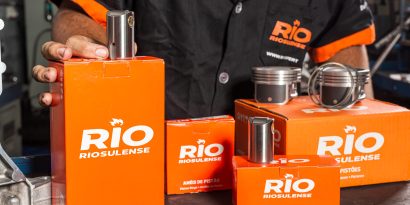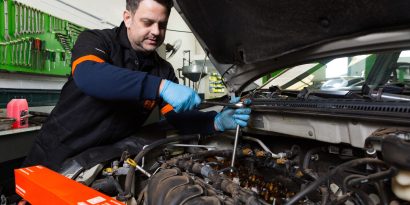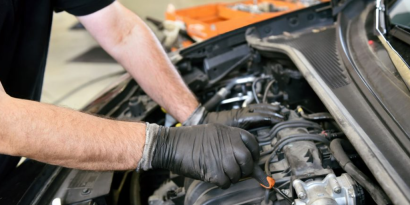Maybe you don’t know what an oil can is, but you certainly know the most classic representation of this item, present not only in the image that illustrates this post, but in basically all vehicle dashboards in the world and that, when it appears, is a sign of problem: the oil pressure in the engine light. The warning, which has a shape similar to a small jar, serves to warn the driver that something is wrong with the car’s lubrication system.
And if you consult your vehicle’s manual at this very moment, you will see that the official recommendation for when this warning comes on is to look for a shoulder (off ramp) and turn off the engine as soon as possible. This is because the lack of oil in the system can cause serious problems in the components, such as the accelerated wear of the parts and even the complete locking of the engine.
That is, it is no wonder that the famous “oil light” is always so surrounded by apprehension, both among mechanics and experienced drivers. In this article, we will explain a little better the importance of oil pressure in the engine and understand the consequences of neglecting this care!
How lubrication helps the engine
If you follow us here on the RIO blog, you may have noticed that, time and again, the care with engine lubrication is back on the agenda. And for good reason: oil is always a relevant subject, mainly for its function, which is to maintain low friction and temperature stability in moving parts.
Crankshaft, pistons, bearings, piston rings, cylinder liners, tappets and all items that are part of the head depend on the constant maintenance of the level and pressure of the oil in the engine, which is put into circulation at the start and during the operation of the vehicle.
Main causes of loss of oil pressure in the engine
The problem, however, begins when the alert on the dashboard indicates the loss of this pressure, which can arise from various causes and, today, we will study the main ones! Join us!
Oil at Wrong Specification for Engine
The type of oil used in the engine also plays an important role when choosing the product. They are generally divided into synthetic oils, mineral oils and semi-synthetic oils. It may seem like an exaggeration, but the truth is that not all oil guarantees adequate engine protection, nor is it capable of providing the performance desired by those behind the wheel.
Here, the tip is to follow the recommendation of the manufacturer’s manual to avoid problems, as the original system was designed and sized for that specification. Using an oil thinner than that specified in the manual, for example, can cause pressure loss at high temperatures, damaging the components.
Problems with the oil filter
The oil filter is applied to the engines of the cars to protect them from debris that is formed by the operation of the engine at high temperature. Remember that the natural wear of the liners, pistons and rings generates small particles that, when circulated by the engine, can cause great damage to the operation, and the oil filter is responsible for retaining these substances.
That is why, too, the exchange of this component is so important from time to time. When it loses its filtering function, all the particles that should be retained in the filter end up coming into contact with the engine parts, overheating the system and decreasing the oil pressure in the engine.
Oil temperature too high
You may not know it, but lubricating oil has properties to maintain viscosity even at high temperatures. But there is a limit. Vehicles that maintain high working speeds for long periods may have oil pressure problems due to temperature.
Do not forget that in such cases the oil may exceed the maximum working temperature — especially if the engine oil level is already lower than recommended. This causes it to lose viscosity and stop being pumped through the system with the same pressure. Result? Oil light on the dashboard!
Damaged oil pump
Another possible cause for the warning may be in the oil pump. This item, which is installed near the engine crankcase, has a valve that regulates the passage of oil and its direction. If the valve remains open longer than necessary, the oil ceases to circulate through the engine in the same volume and the pressure in the pump may drop.
Likewise, if the regulating valve is closed, it will exceed the pressure that the system supports and may cause leakage through the oil filter or even its movement. Therefore, it is worth checking the performance of the pump and testing the opening flow of the valves!
Low oil level in the crankcase
And speaking of the crankcase — the part that occupies the bottom of the engine and acts as a reservoir for retaining lubricating oil — it is important to remember that if the oil level in this reservoir is too low, the pressure will also drop and the light on the dashboard will turn on, indicating the problem.
Do you know when the car is “leaking oil”? This usually happens when there is a problem in the crankcase and, therefore, it is always worth checking the integrity of this part, especially if the driver notices that oil puddles are forming on the floor when the vehicle spends a lot of time standing still!
Give your repair shop customers more peace of mind with RIO
To close, it is worth an extra tip on the house: using parts of dubious quality and without guarantee of origin is a surefire recipe to accelerate engine wear and compromise the efficiency of the lubricating oil. This is because these parts wear out and release polluting residues in the oil much more easily.
So get away from these uncertainties and bet on a supplier with proven history, quality and efficiency! Here at RIO, your workshop finds thousands of spare parts produced with state-of-the-art technology, all to ensure the best performance with much more safety for your repairs!





